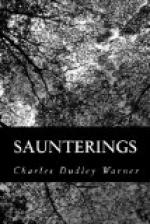A little weary with the good but damp old Christians, we ordered our driver to continue across the marsh to the Pineta, whose dark fringe bounded all our horizon toward the Adriatic. It is the largest unbroken forest in Italy, and by all odds the most poetic in itself and its associations. It is twenty-five miles long, and from one to three in breadth, a free growth of stately pines, whose boughs are full of music and sweet odors,—a succession of lovely glades and avenues, with miles and miles of drives over the springy turf. At the point where we entered is a farmhouse. Laborers had been gathering the cones, which were heaped up in immense windrows, hundreds of feet in length. Boys and men were busy pounding out the seeds from the cones. The latter are used for fuel, and the former are pressed for their oil. They are also eaten: we have often had them served at hotel tables, and found them rather tasteless, but not unpleasant. The turf, as we drove into the recesses of the forest, was thickly covered with wild flowers, of many colors and delicate forms; but we liked best the violets, for they reminded us of home, though the driver seemed to think them less valuable than the seeds of the pine-cones. A lovely day and history and romance united to fascinate us with the place. We were driving over the spot where, eighteen centuries ago, the Roman fleet used to ride at anchor. Here, it is certain, the gloomy spirit of Dante found congenial place for meditation, and the gay Boccaccio material for fiction. Here for hours, day after day, Byron used to gallop his horse, giving vent to that restless impatience which could not all escape from his fiery pen, hearing those voices of a past and dead Italy which he, more truthfully and pathetically than any other poet, has put into living verse. The driver pointed out what is




